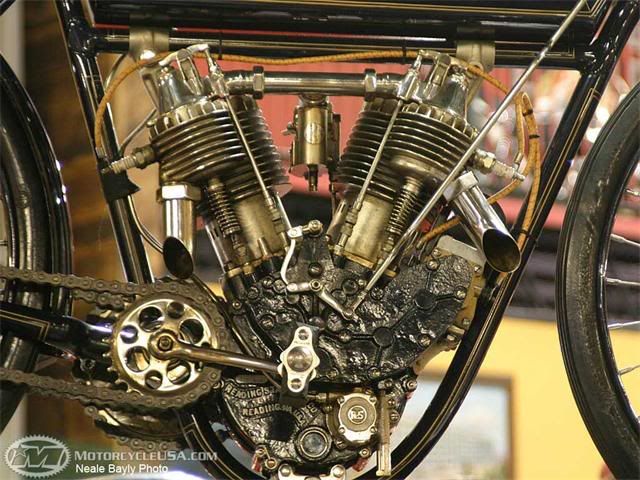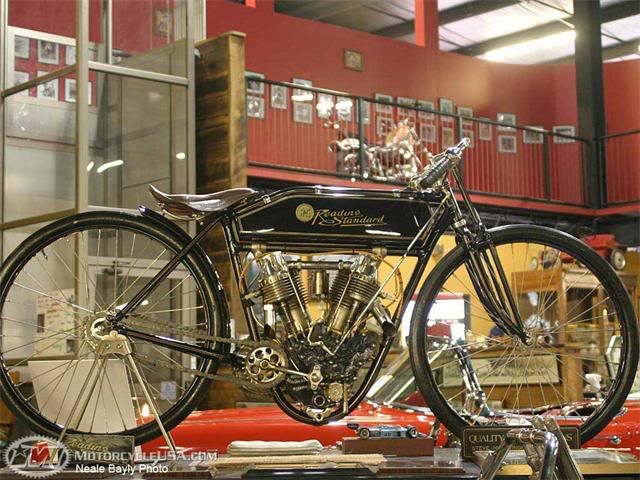I've been cruising around the internet, looking for great motorcycle related web-sites and blogs. I found one that is sure at the top of my "FAVORITES" tab!
I am impressed with the work these devoted blog and web-masters have infused into their web-sites!
If you would like to see the website in it's entirety, please click on the title below:
Moto-History: Reading-Standard
In an effort to improve the quality of internet content available for some of the more rare models of motorcycles, Teknikka has begun to re-publish articles from the early 1900’s that have passed into the public domain. We will start with an article from October 1921 issue of Motorcycle Illustrated about Reading-Standard’s 1922 product offering:
WE shall adhere to our policy of specializing on one model,” said General Manager A. E. McGavin, when asked what the Reading Standard had to announce for the 1922 season. “For five years this factory has put all of its energy back of a single model, and we believe we have de veloped the best machine of its type on the American market. We propose to make it still better by sticking right to it.”
No Fundamental Changes
No radical changes have been incorporated in the 1922 R-S. Since all claims by the Reading Standard Company are made for its stock motor, and inasmuch as they strongly contend that specials prove nothing, it is only natural that they should endeavor to perfect and improve wherever possible their stock twin motor, which has won for the R-S all its laurels.
The R-S factory, for the past five years, has specialized on making their super- powered twin cylinder motor with side by side mechanically operated valves, motor displacing 71.57 cu. in. At a glance the 1922 R-S motor shows no changes, but certain refinements have been made which not only add to the power, but produce a much smoother running engine.
The dimensions of the valve lift levers have been greatly increased. These lift levers and all cams, gears, shafts, etc., are made from vanadium steel. The “sloped-head” constructive type of cylinder head is continued. This construction permits the elimination of eddy-producing pockets and restricting corners. The intake and exhaust passages have sweeping curves and the intake passage of the R-S is short and direct.
The bore and stroke of the R-S remains at 3 3/8×4 in. respectively, giving a displacement of 71.57 cu. in. Each cylinder is fitted with the R-S priming cup.
The valves are of the R S side by side arrangement, 1 3/4-in. in diameter. The exhaust valve is made from silchrome steel, while the intake valve is provided with a welded-on cast iron seat. Both valves are solid forgings. The angle of the valve seats is 45 degrees and 7/8-in. diameter vanadium steel valve springs are employed, encased in a spring cover, within which ample clearance is provided to prevent friction between spring and cover. The removal of these covers is very simple, screwing down a nut below the bottom cap permits the cover to be removed easily and completely from the spring.
The pistons are the same as heretofore, carrying three diagonally cut eccentric rings 3/16 in. wide. Piston pins are £i-in. in diameter, turned from a solid bar, secured in the pistons with a special 1/4-in. pin, headed at one end and split at the other.
Connecting rods are of the drop-forged “I-beam” construction, carrying bronze bushings at the upper end and operating on a hardened steel sleeve which houses the lower roller bearing. The R-S construction of the lower bearings differ from the usual practice, in that there is not an individual row of roller bearings for each connecting rod member.
No change has been made in the crank case, or cam case.
Slight changes have been made in the mechanical oiler. The auxiliary hand oil pump is continued.
Bosch magnetos are standard equipment for 1922.
The electrically equipped machines will use Bosch magnetos and the Splitdorf separate generator in connection with Wico battery. The Splitdorf generator is neatly and substantially mounted on a bracket secured by the front motor bolts. The driving pulley is riveted to the motor sprocket.
The electric switch is a decided improvement over any switch heretofore used on any motorcycle. All lights are controlled from one rotating button, which allows for the following combinations with the ratchet lock handle :
First turn, rear light.
Second turn, rear and drive.
Third turn, rear and head.
Fourth turn, all off.
The construction is of special waterproof material with heavy brass contact parts. The circuit arms are of stamped copper, thus ensuring a positive contact at all times. Two important features are the fact that contact parts are forced in place with steel spiral spring and held permanently—vibration cannot disengage it. There is no fibre used in the switch to swell when switch becomes damp. The method of wiring is simple, only four wires attached to switch, one each, tail, dim, bright and positive. The combinations are made automatically with the tail lamp. The switch is covered with insulated nickel-plated shell 1-15/16-in. diameter, 1 1/2-in. high, bolted to front of tool box and easily accessible.
A 1-in. Schebler carburetor embodying the latest improvements is supplied.

Transmission
The R-S gear box is retained. The main shaft is mounted on over-size ball bearings and carries the high, shifting and low-speed gears. The countershaft is 3/4-in. and the secondary gear is mounted on two heavy bronze bearings with an oil pocket between.
The kick starter will be of the standard gear and the segment type as formerly used.
An oversize dry plate Eclipse clutch with Raybestos linings are rivited to the steel plates, is standard equipment.
A 3/8-in. and 3/8-in. heavy Duckworth chain will be used.
Gear Ratio
The standard gearing will be 3.91 to 1 on high, 6 to 1 on second and 9.2 to 1 on low. For sidecar service a 14-tooth motor sprocket is available.
The double-braking system on the rear wheel and the regular Bowden wire controls are continued. The clutch is operated by the familiar R-S dual hand lever and foot control on the left side.
Mesinger saddle mounted on the regular R-S spring scat post will be this year’s equipment.
Slight changes have been made in the R-S muffler. The tail pipe has been lengthened and flattened on the end. It is 2-in. in diameter, has no restricting back pressure and is mounted low and out of the way.
The capacity of the tank provides for 3 gallons of gasoline and 1 gallon of oil.
The only change in the frame is the adoption of heavier tubing. Sidecar lugs are integral with the frame. Finish
The 1922 R-S presents an entirely different appearance. The color for this year is “R-S Superior Brown.” a beautiful shade.
Models and Prices:
Magneto Model $345.00
Electrically equipped 375.00

We are adding many more of these in the Teknikka Wiki under their specific make or model. If you have any articles published prior to 1923, they are in the public domain. Please help us expand the library by submitting them for re-publication.
If you are a motorcycle history nut, join us here at Teknikka and meet others that share your passion.










0 comments:
Post a Comment